This dinner roll recipe took Chef Rachel Farnsworth over 5 years of testing to develop. It has since been enjoyed by millions of people around the world with thousands and thousands of rave reviews, heralded as the best dinner rolls on the internet. In addition to being published in her best-selling cookbook The Stay At Home Chef Family Favorites, this dinner roll recipe is used in restaurants and bakeries around the world. And now, it’s all yours!
Why Our Recipe
- Tried and true recipe for soft, fluffy, buttery dinner rolls worthy of a bakery every time.
- This recipe works for any skill level. Use a stand mixer or knead by hand.
- Make ahead instructions and freezer instructions included!
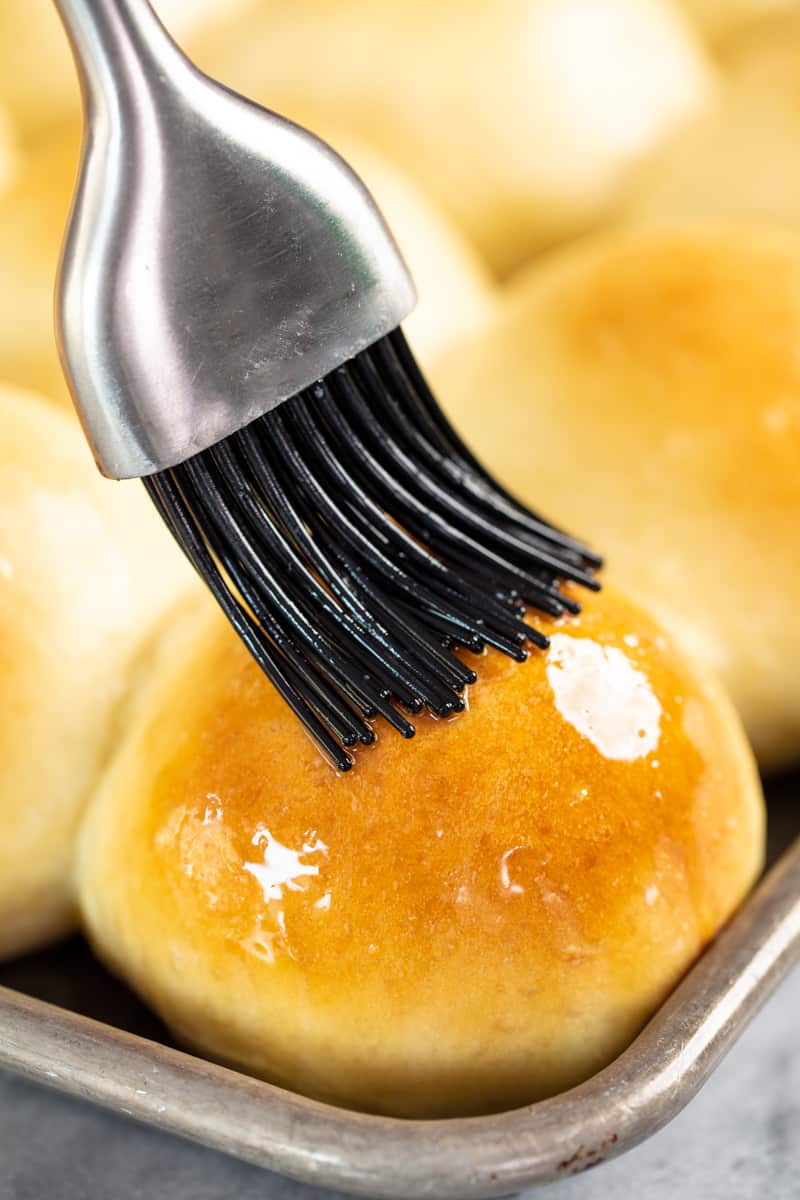
Whether you are new to bread making or an experienced baker, this recipe is sure to please. These homemade dinner rolls deliver bakery-quality results every single time. Whether you’re a seasoned baker or a beginner, this recipe has you covered. Use a stand mixer for convenience or knead the dough by hand if you prefer a more hands-on approach. You’ll get pillowy soft melt-in-your-mouth perfection either way!
Ingredient Notes
- Warm Milk: Make sure the milk is between 100°F to 110°F. Heat it on the stove or in the microwave. Use a thermometer for accuracy or test with your finger—it should feel warm but not hot. Use whole milk, 2% or 1% for best results. Skim and dairy milk alternatives can also work.
- Instant Dry Yeast: Instant yeast doesn’t need to be activated beforehand. If you only have active dry yeast, adjust the rising times slightly as noted in the instructions.
- Granulated Sugar: Yup, just regular old sugar. Brown sugar can also be used if you want to add in that hint of molasses.
- Salt: Stick with standard table salt for accurate measurements.
- Salted Butter: Make sure you use softened butter so it mixes in to the dough. If you only have unsalted butter, add an extra pinch of salt.
- Eggs: Grade AA large eggs will do.
- All-Purpose Flour: Start with 5 1/2 cups and gradually add more as needed. Bread flour can be used in the same amount for a slightly chewier texture, using the same amount.
- Melted Butter: Brushed on after baking for a shiny finish and buttery flavor.
No stand mixer? No Problem!
You can knead your dough by hand! Start out by stirring with a spoon until it becomes too difficult to stir. Turn the dough out onto a clean surface and knead it with your hands, gradually adding in more flour and folding, pressing, and working the dough (kneading) until you have a soft and smooth dough ball that is tacky, but not sticky enough to stick to your hands.
Active Dry Yeast Vs Instant
Instant dry yeast can be added straight to dry ingredients and doesn’t require any waiting period or proofing. It also rises a bit quicker. Active dry yeast is a bigger size of granule and generally needs to be dissolved in a liquid before adding to a recipe. It activates a bit slower so expect 10-15 minutes extra in rising time.
Go by Feel
The exact amount of flour you add in bread making can vary a great deal so it’s important to go by feel. I like to say you can feel a soft roll just by touching the dough. The dough should be smooth and slightly tacky, but still very soft and pliable. If it is sticking to your hands or the sides of the bowl, you need more flour. If you add too much flour and the dough stiffens, your rolls will also get a little stiff so always add additional flour a small amount at a time.
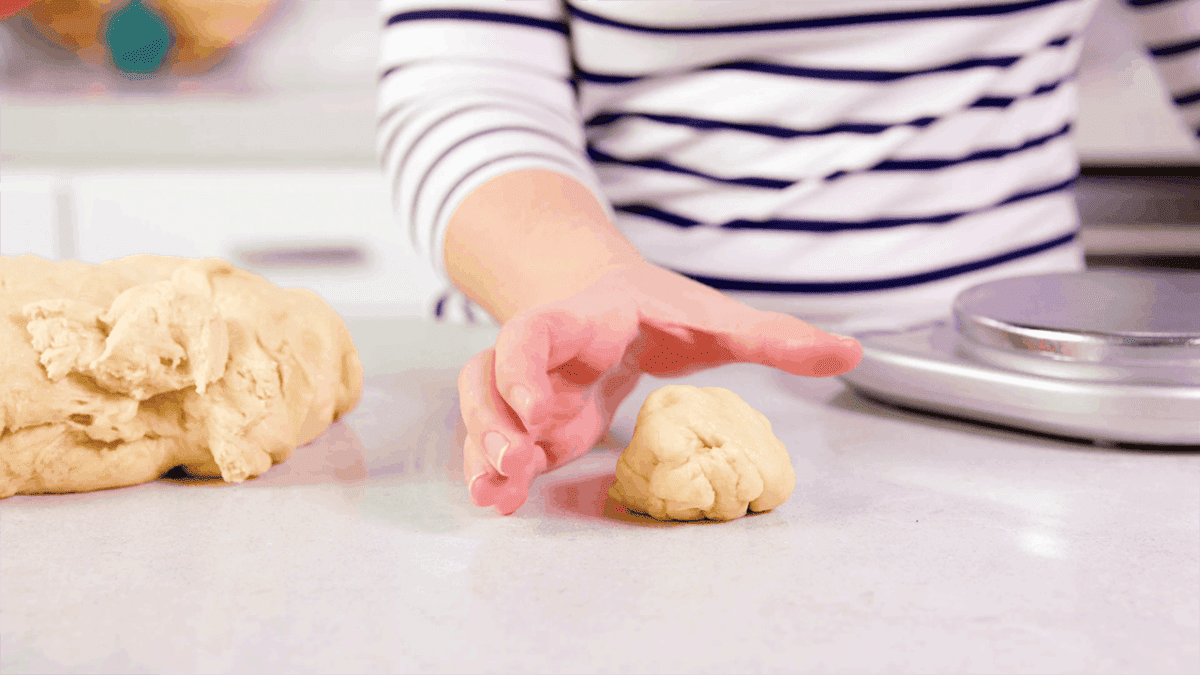
Pro Tip: Equal Size Rolls
The best way to ensure that your rolls are equal in size is to weigh them. Weigh the entire batch of dough using a kitchen scale and divide that weight by 24. This will give you your target weight for each roll. Usually, this is somewhere around 2.5 ounces.
Shaping Rolls
Once you have your dough divided into 24 pieces you can shape your rolls. Place your hand into a cupping shape parallel to a clean countertop. Place the dough ball between the palm of your hand and the countertop. Roll the dough in a circular motion between your palm and the countertop for approximately 30 to 45 seconds until you have a smooth, round ball.
Measuring Flour
The flour you buy at the store these days is generally pre-sifted. There is no need to sift your flour. I prefer the scoop and sweep method as it is ultra-convenient. Simply give your flour a fluff, use your measuring cup to scoop out the flour, and level off the top. Weighing your flour using a kitchen scale is the only way to ensure complete accuracy. Even then, bread making is both fickle and forgiving and the actual amount of flour you add can change just due to the humidity in the air. When making this roll recipe, it is best to go by the touch and feel of the dough. 1 cup of flour is approximately 125 grams.
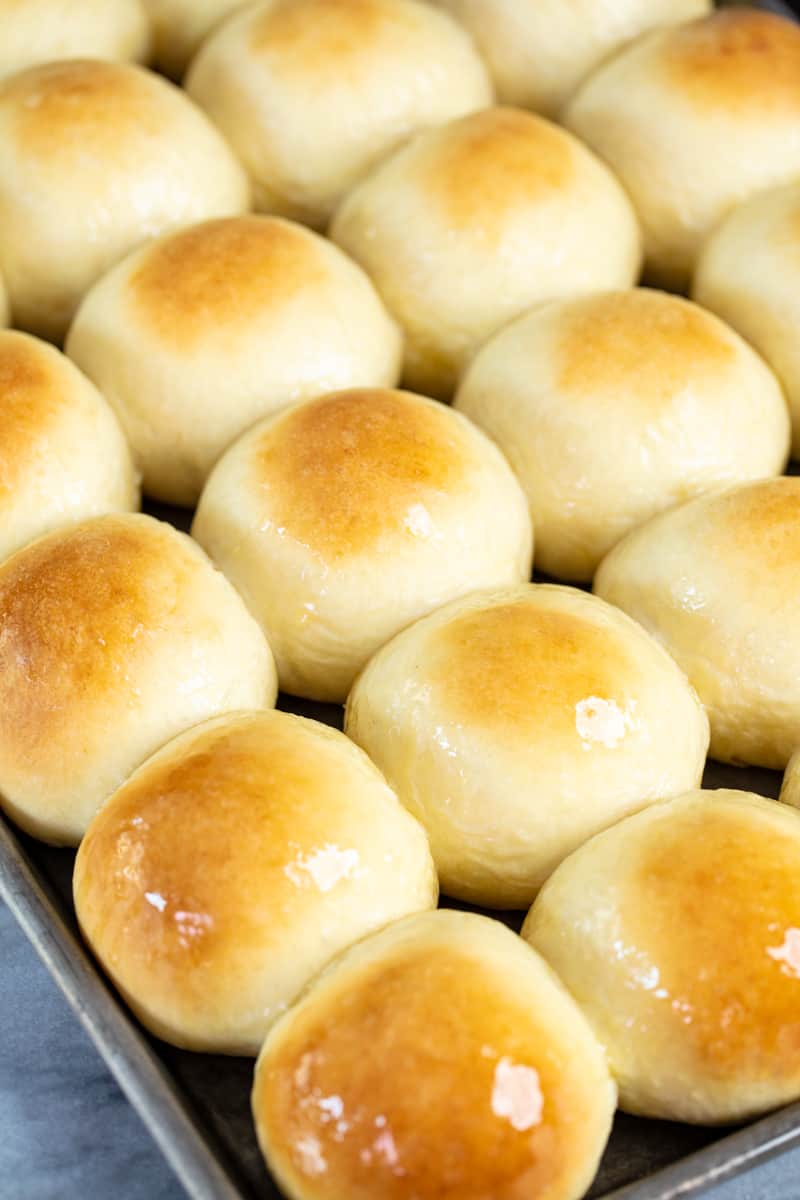
Freezer Instructions
You can freeze dinner rolls for later baking immediately after you shape them into rolls. When ready to eat, remove them from the freezer and allow to thaw and produce their second rise until double in size before baking. This can take anywhere between 1 to 2 hours, depending on the temperature in your home.
Make-Ahead Instructions
Need to make your dough ahead of time while you are busy doing other things? Make your dough as directed and let it rise for the initial 90 minutes. Shape the dough into rolls and place them on your baking sheet. Instead of letting them rise for an additional 60 minutes, cover the shaped rolls with plastic wrap and place the pan directly into the refrigerator. While it doesn’t stop it completely, the cool temperature of the fridge will slow the growth of your yeast. Your rolls will only rise slightly while refrigerated and you can hold them this way for up to 24 hours.
When ready to bake, remove them from the fridge and allow the rolls to rise at room temperature while your oven preheats, about 30 minutes. Continue to bake as directed.
Storage Instructions
Store in a plastic bag or airtight container at room temperature for up to 72 hours.
More perfect bread recipes…
Best Homemade Cinnamon Rolls Ever
2 hrs 14 mins
Ultimate Guide to Homemade Bread
3 hrs 25 mins
Homemade Breadsticks
1 hr 18 mins
Watch the video below where Rachel will walk you through every step of this recipe. Sometimes it helps to have a visual, and we’ve always got you covered with our cooking show. You can find the complete collection of recipes on YouTube, our Facebook Page, or right here on our website with their corresponding recipes.

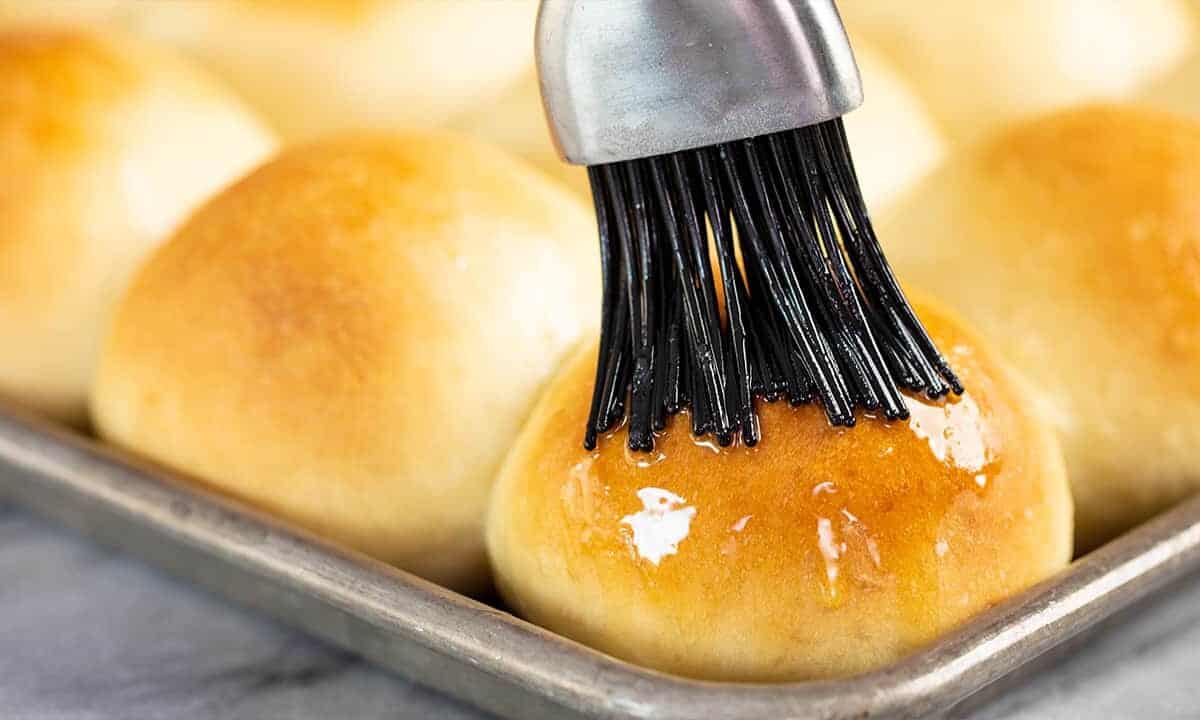
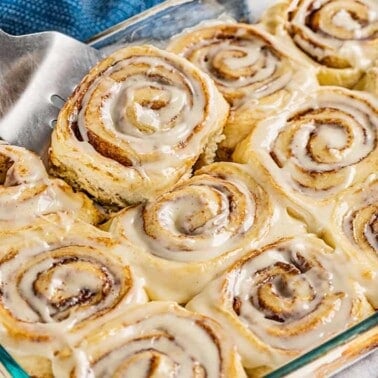
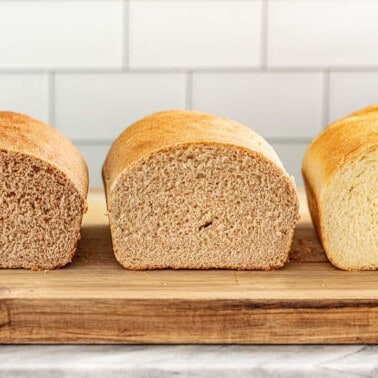
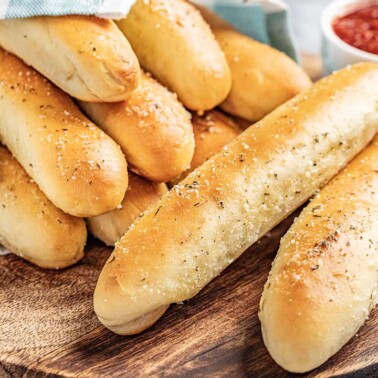
I’ve made these twice and the taste is wonderful but they are a little too soft on the inside…almost gooey. I let them bake longer the 2nd time but they were still too soft in the inside. Any suggestions?
Are you making 24 rolls? If they are too big they may have trouble baking inside.
Yes, I made 24 and they had plenty of room to expand.
check your oven temperature, it may need to be recalibrated.
2 questions: Any advice for high altitude adjustment? Have you ever tried with whole wheat flour? Thanks!
I’ve baked this successfully many times at 4500 feet and many more times at 0 feet.
And wheat flour….has a way of ruining things. The roll is just much more dense and not so light and fluffy.
To freeze these, after I shape them do I put them in a zip lock bag or keep them on the pan? I want to make them for thanksgiving so would they taste the same if I made them now and froze them or should I just wait until thanksgiving morning?
I’d freeze them individually to be sure they don’t all stick together.
my dad has made these rolls the other day. Very good by the way, He made another batch for Thanksgiving and let them rise before freezing them and they fell. Will they rise back up again are what can he do?
If they rise and fall then you have let them rise too long. Rising time is always an estimate since it depends on a variety of factors like the exact temperature of your house.
So they are no good now. And he needs to just start over fresh.
I’m sorry, I tried to scan thru the comments to see if this was already answered. Do you actually warm up the milk or just leave it on the counter until it gets warm?
I warm it up in the microwave. Letting it sit on the counter isn’t food safe.
Could these be baked in a disposable aluminum pan? (maybe 12 in each pan with disposable pans typically being smaller?) I wanted to take these with me to thanksgiving dinner but wasn’t sure if they would bake up correctly in a disposable pan. Thanks in advance!
Yes, that should work!
I just made these rolls and they look and smell fabulous!!! The next time I make them I will make them smaller (2 oz) so they make more. Hope they last until Thanksgiving! Thanks for the recipe Rachel!!
need in USA mesurments. cups, teaspoons, tablespoons and etc
There are two recipes listed above…the first is the USA measurements. The second was added due to popular demand with the metric measurements.
Where are the FAQ’s? I have scrolled all the to the bottom and I don’t see them. Thank you.
Right up there ^^^
I have made bread for years but always scalded and cooled the milk. Is this no longer necessary?
Unnecessary nowadays! You now have permission to save some time and eat your rolls sooner 🙂